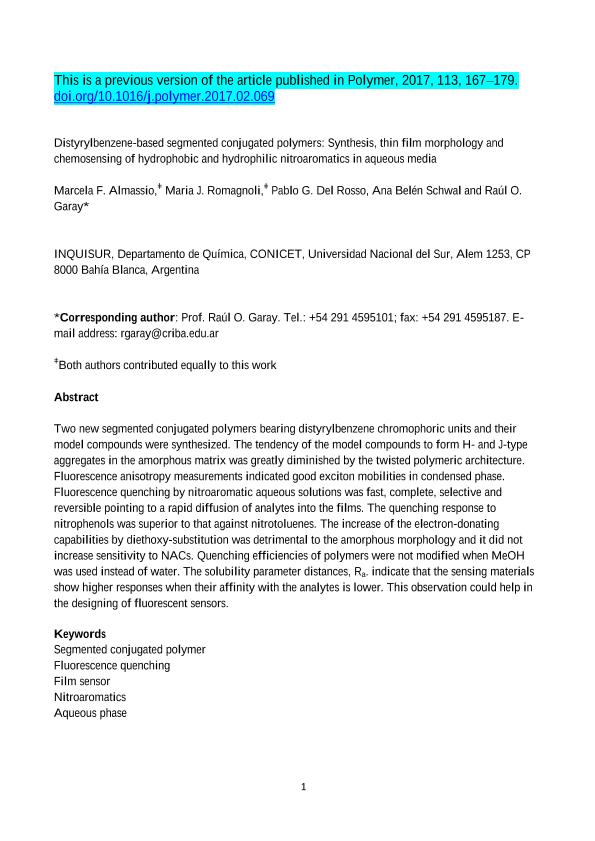Artículo
Distyrylbenzene-based segmented conjugated polymers: Synthesis, thin film morphology and chemosensing of hydrophobic and hydrophilic nitroaromatics in aqueous media
Almassio, Marcela ; Romagnoli, Maria Jose
; Romagnoli, Maria Jose ; del Rosso, Pablo Gabriel
; del Rosso, Pablo Gabriel ; Schvval, Ana Belén
; Schvval, Ana Belén ; Garay, Raúl Oscar
; Garay, Raúl Oscar
 ; Romagnoli, Maria Jose
; Romagnoli, Maria Jose ; del Rosso, Pablo Gabriel
; del Rosso, Pablo Gabriel ; Schvval, Ana Belén
; Schvval, Ana Belén ; Garay, Raúl Oscar
; Garay, Raúl Oscar
Fecha de publicación:
03/2017
Editorial:
Elsevier
Revista:
Polymer
ISSN:
0032-3861
Idioma:
Inglés
Tipo de recurso:
Artículo publicado
Clasificación temática:
Resumen
Two new segmented conjugated polymers bearing distyrylbenzene chromophoric units and their model compounds were synthesized. The tendency of the model compounds to form H- and J-type aggregates in the amorphous matrix was greatly diminished by the twisted polymeric architecture. Fluorescence anisotropy measurements indicated good exciton mobilities in condensed phase. Fluorescence quenching by nitroaromatic aqueous solutions was fast, complete, selective and reversible pointing to a rapid diffusion of analytes into the films. The quenching response to nitrophenols was superior to that against nitrotoluenes. The increase of the electron-donating capabilities by diethoxy-substitution was detrimental to the amorphous morphology and it did not increase sensitivity to NACs. Quenching efficiencies of polymers were not modified when MeOH was used instead of water. The solubility parameter distances, Ra. indicate that the sensing materials show higher responses when their affinity with the analytes is lower. This observation could help in the designing of fluorescent sensors.
Archivos asociados
Licencia
Identificadores
Colecciones
Articulos(INQUISUR)
Articulos de INST.DE QUIMICA DEL SUR
Articulos de INST.DE QUIMICA DEL SUR
Citación
Almassio, Marcela; Romagnoli, Maria Jose; del Rosso, Pablo Gabriel; Schvval, Ana Belén; Garay, Raúl Oscar; Distyrylbenzene-based segmented conjugated polymers: Synthesis, thin film morphology and chemosensing of hydrophobic and hydrophilic nitroaromatics in aqueous media; Elsevier; Polymer; 113; 3-2017; 167-179
Compartir
Altmétricas



